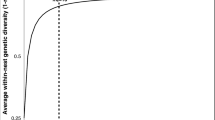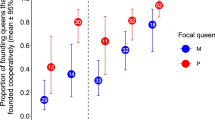Summary
We propose two models for the inheritance of the innate components of colony odor in social Hymenoptera. Under the Individualistic model, individuals are hostile unless they share at least one allele at all colony-odor loci. Under the Gestalt model, colony-odor pheromones are transferred between individuals, resulting in a ‘gestalt’ colony odor; colonies will not fuse unless they have the same genetic mix of workers. We analyze these models for the case of colonies founded by single, once-mated queens. The Gestalt model seems generally favored for most species, although some evidence suggests the Individualistic model may operate in some primitive ants. A single colony-odor locus is possible in the Gestalt model, but seems improbable in the Individualistic case. We propose a general inbreeding test to estimate the number of loci involved in colony odor.
Similar content being viewed by others
References
Barrows, E.M., Bell, W.J., Michener, C.D.: Individual odor differences and their social functions in insects. Proc. Natl. Acad. Sci. USA 72, 2824–2828 (1975)
Brown, W.L.: An hypothesis concerning the function of the metapleural glands in ants. Am. Nat. 102, 188–191 (1968)
Burnet, F.M.: Multiple polymorphism in relation to histocompatibility antigens. Nature 245, 359–361 (1973)
Chauvin, R.: Animal societies from the bee to the gorilla (trans. G. Ordisk). New York: Hill and Wang 1968
Crozier, R.H.: Heterozygosity and sex-determination in haplodiploidy. Am. Nat. 105, 399–412 (1971)
Crozier, R.H.: Evolutionary genetics of the hymenoptera. Annu. Rev. Entomol. 22, 263–288 (1977)
Hangartner, W., Reichson, J.M., Wilson, E.O.: Orientation to nest material by the ant, Pogonomyrmex badius (Latreille). Anim. Behav. 18, 331–334 (1970)
Haskins, C.P., Haskins, E.F.: Notes on the biology and social behavior of the archaic ponerine ants of the genera Myrmecia and Promymecia. Ann. Entomol. Soc. Am 43, 461–491 (1950)
Hubbard, M.D.: Influence of nest material and colony odor on digging in the ant Solenopsis invicta (Hymenoptera: Formicidae). J. Ga. Entomol. Soc. 9, 127–132 (1974)
Imai, H.T., Crozier, R.H., Taylor, R.W.: Karyotype evolution in Australian ants. Chromosoma 59, 341–393 (1977)
Ribbands, C.R.: The role of recognition of comrades in the defence of social insect communities. Symp. Zool. Soc. Lond. 14, 159–168 (1965)
Wright, S.: Evolution and the genetics of populations, Vol 2, the theory of gene frequencies. Chicago: University of Chicago Press 1969
Author information
Authors and Affiliations
Rights and permissions
About this article
Cite this article
Crozier, R.H., Dix, M.W. Analysis of two genetic models for the innate components of colony odor in social Hymenoptera. Behav Ecol Sociobiol 4, 217–224 (1979). https://doi.org/10.1007/BF00297645
Received:
Issue Date:
DOI: https://doi.org/10.1007/BF00297645




